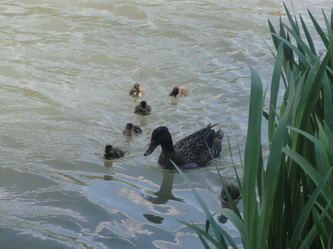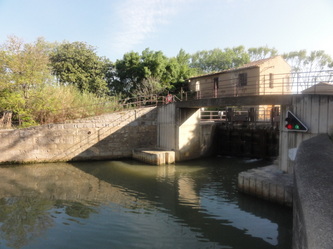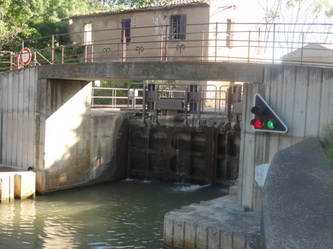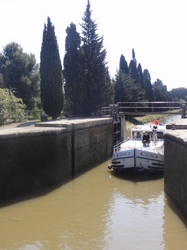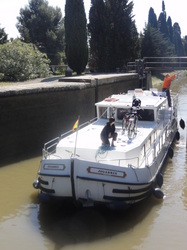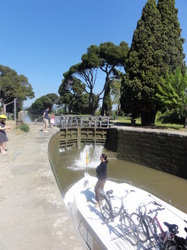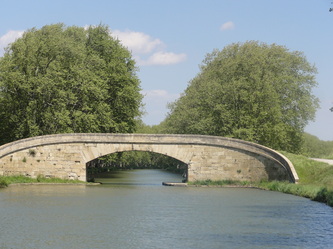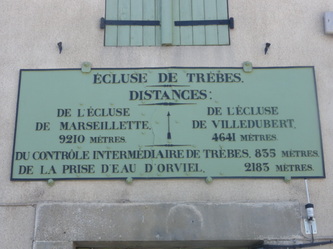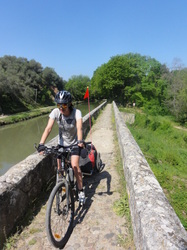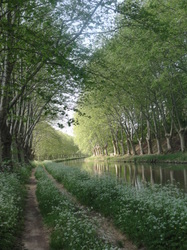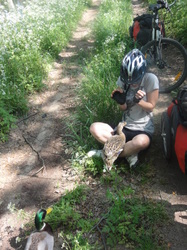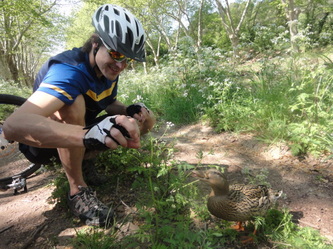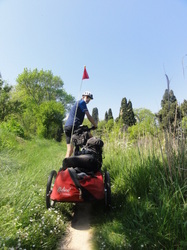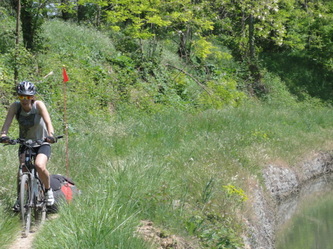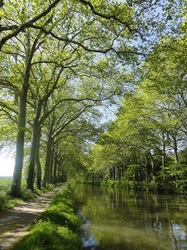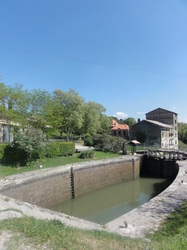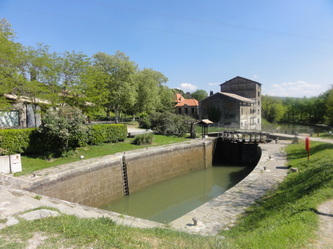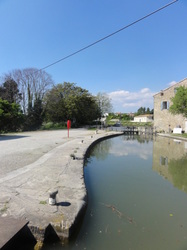So, we arrived in Toulouse at about 3pm yesterday, having completed 300klms along southern France's famed Canal du Midi on our new steeds.
The Canal du Midi is a 240klm long canal in southern France, made by rich farmer Pierre-Paul Riquet in 1667 - when he was 63 years old (he didn't do ALL the work himself). The Canal du Midi connects the Atlantic and the Mediterranean - and is a true aqua engineering marvel. Apparently Riquet had a team of 12,000 men help him build it - but over 1,000 waterway dwelling women provided the necessary practical water management knowledge to make it a success! It is a beautiful and majestic thing too - and cycling along it is superb for the most part.
The hardly changing canal is very serene, with still, opaque green waters. We enjoyed cycling it, and this despite the fact that our heavy, cumbersome two-wheeled trailers (width at wheels approx 80-90cms) were not at all ideal for many sections of the bike path. The worst being the 10-15 cm wide dirt track surrounded by long thick grass (much drag) and the gravelly, slatey, pot-holed areas with tree roots aplenty emerging at unpredictable place - our trailers cannot stand their wheels being too uneven. So, a surprise tree root can easily tip you over...I was thrown sideways off my bike without any warning when a hidden root upended my trailer, and very nearly ended up having a dip in Riquet's serene waterway. In fact, it must have been a day for falls as I also went down when I moved aside to let some other cyclists pass - and the ground under my left foot was actually just long grass over a ditch. Damn...
Here is a map of the Canal du Midi: http://en.wikipedia.org/wiki/File:Canal_du_Midi_map-fr.svg
The most amazing part of the Canal though are the ecluses - these are 91 oval, 100 ft long phenomenal aqua locks that allow the canal to ascend and descend 190 metres (yeah, and we rode uphill all the way!). The canal has 328 structures - bridges, dams and a tunnel. The ecluses manage the water at vastly different heights above sea level. I don't know any of the specific engineering terms - but watching an ecluse equalise the water so a boat can pass smoothly is splendid! The boat must enter the lock itself via a steel gate, and then the opposing gate at the other side of the lock lets the water either in to raise the level in the lock to match the other side, or vice versa. The boat then rises or descends smoothly with the rushing water in side the oval lock, and then the facing gates open and it passes through. I took a movie of it - which I'll try to post as it really is impressive!
Toulouse, our current location, is where the Canal ends - and I will be a bit sad to no longer be alongside it. But, Bordeaux awaits and I suppose the vins on offer will usher me through my grief.
I have to record some superb recipes here, but before that will quickly note that Jamie's lovely 'Stand by me' blog prettied up the train bridge episode quite a bit! It was not fun. JB was fairly sanguine, but I have a moderate train phobia and felt like throwing up before and during the crossing. The bridge was FAR longer than it looks in the photos, and the corner FAR blinder (is that a word?). Anyway, the truth of it was we wouldn't have been able to see a train until it was on the bridge with us. This made me very uncomfortable. The bridge was about 5 metres above the canal - but even jumping off wasn't a great option as the water was flowing rapidly towards a rocky rapid only a few metres away. We nearly didn't make it over the bridge as I very nearly refused to do it.
Prior to and during the crossing of the train bridge was the first time I thought "Why the hell can't we just have a normal European vacation like other people do? Do we really need to run with 100+kgs of bikes/trailers across a train bridge to enjoy ourselves?" Anyway. After we made it, I remembered I prefer this type of adventure.
Recipe of the Week: There's deux!
Crazy french pizza - I've forgotten the name
-Home made pizza base (probably wholemal would be best), rolled out thinly.
-Cream fraiche
-Chevre (goat's cheese - small rounds with rind would be best - but soft would be good also)
-Emmenthal
-Artichoke hearts - cut into wedges
-Black olives
-If you wanted - I think that caramelised leeks or red onion would also be lovely on this guy.
So, assemble all the delicious ingredients over your base - I guess cream fraiche first, then place the slices/rounds of goats' cheese and then the artichoke wedges, then olives and emmenthal.
Bake on a pizza stone in a really hot oven until it's crisp and brown at the edges - VOILA!
Best pizza ever.
Moules au Roquefort
I don't have time now to try to invent a recipe for this, but basically - clean your mussels, and then steam just open in fish stock/wine/butter and put aside. Gently heat some cream/cream fraiche (no boiling!) in a massive pot and when it's warm melt in a massive chunk of roquefort. Don't worry if the texture is inconsistent...Season if you want to. If it's not liquidy enough - add a little of the liquid the mussels were cooked in.
Then just chuck in the mussels and stir them around so they are happily swimming and dancing.
EAT the little creatures with home made brown frittes or with the best crusty brown bread you can find, and a good vin blac.
mmmmmmmmmmmmmmmmmmmmmmmmmmmmmmmmmmmmmmm
Random fact of the week:
-A swan attacked me. The bastard.
Canal du Midi fast facts and accolades for the water women (thanks Wikipedia: http://en.wikipedia.org/wiki/Canal_du_Midi):
"The system was a masterpiece of both hydraulic and structural engineering, and served as an early ratification of Riquet's vision. It was also a major part of a massive enterprise. At its peak 12,000 labourers worked on the project, including over a thousand women, many of whom came specifically to work on the water system.[2][3][4] The women labourers were surprisingly important to the canal's engineering. Many came from former Roman bath colonies in the Pyrenees, where elements of classical hydraulics had been maintained as a living tradition. They were hired at first to haul dirt to the dam at St. Ferréol, but their supervisors, who were struggling to design the channels from the dam to the canal, recognized their expertise. Engineering in this period was mainly focused on fortress construction, and hydraulics was concerned mostly with mining and problems of drainage. Building a navigational canal across the continent was well beyond the formal knowledge of the military engineers expected to supervise it, but the peasant women who were carriers of classical hydraulic methods added to the repertoire of available techniques. They not only perfected the water supply system for the canal but also threaded the waterway through the mountains near Béziers, using few locks, and built the eight-lock staircase at Fonserannes.[3]"
Specifications
Canal length: 240 km (150 mi) Max boat length: 30 m (98 ft) Max boat beam: 5.5 m (18 ft) Original locks: 86 Current locks: 65 Minimum height above sea level: 0 m (0 ft) Maximum height above sea level: 190 m (620 ft) Navigation Authority: VNF
History
Original owner: Pierre-Paul Riquet Principal Engineer(s): Pierre-Paul Riquet Other Engineer(s): Marshal Sebastien Vauban, Louis Nicolas de Clerville, François Andréossy
Date approved: 1666 Construction began: 1667 Date completed: 5/15/1681
Geography Starts at: Toulouse Ends at: Étang de Thau
Beginning coordinates: 43°36′40″N 1°25′06″E / 43.61102°N 1.41844°E / 43.61102; 1.41844 Ending coordinates: 43°20′24″N 3°32′23″E / 43.34003°N 3.53978°E / 43.34003; 3.53978 Les Onglous lighthouse Branch of: Canal des Deux Mers
Connects to: Garonne Lateral Canal, La Nouvelle branch, Canal de Brienne, Hérault River,and Étang de Thau Summit: Seuil de Naurouze
The Canal du Midi is a 240klm long canal in southern France, made by rich farmer Pierre-Paul Riquet in 1667 - when he was 63 years old (he didn't do ALL the work himself). The Canal du Midi connects the Atlantic and the Mediterranean - and is a true aqua engineering marvel. Apparently Riquet had a team of 12,000 men help him build it - but over 1,000 waterway dwelling women provided the necessary practical water management knowledge to make it a success! It is a beautiful and majestic thing too - and cycling along it is superb for the most part.
The hardly changing canal is very serene, with still, opaque green waters. We enjoyed cycling it, and this despite the fact that our heavy, cumbersome two-wheeled trailers (width at wheels approx 80-90cms) were not at all ideal for many sections of the bike path. The worst being the 10-15 cm wide dirt track surrounded by long thick grass (much drag) and the gravelly, slatey, pot-holed areas with tree roots aplenty emerging at unpredictable place - our trailers cannot stand their wheels being too uneven. So, a surprise tree root can easily tip you over...I was thrown sideways off my bike without any warning when a hidden root upended my trailer, and very nearly ended up having a dip in Riquet's serene waterway. In fact, it must have been a day for falls as I also went down when I moved aside to let some other cyclists pass - and the ground under my left foot was actually just long grass over a ditch. Damn...
Here is a map of the Canal du Midi: http://en.wikipedia.org/wiki/File:Canal_du_Midi_map-fr.svg
The most amazing part of the Canal though are the ecluses - these are 91 oval, 100 ft long phenomenal aqua locks that allow the canal to ascend and descend 190 metres (yeah, and we rode uphill all the way!). The canal has 328 structures - bridges, dams and a tunnel. The ecluses manage the water at vastly different heights above sea level. I don't know any of the specific engineering terms - but watching an ecluse equalise the water so a boat can pass smoothly is splendid! The boat must enter the lock itself via a steel gate, and then the opposing gate at the other side of the lock lets the water either in to raise the level in the lock to match the other side, or vice versa. The boat then rises or descends smoothly with the rushing water in side the oval lock, and then the facing gates open and it passes through. I took a movie of it - which I'll try to post as it really is impressive!
Toulouse, our current location, is where the Canal ends - and I will be a bit sad to no longer be alongside it. But, Bordeaux awaits and I suppose the vins on offer will usher me through my grief.
I have to record some superb recipes here, but before that will quickly note that Jamie's lovely 'Stand by me' blog prettied up the train bridge episode quite a bit! It was not fun. JB was fairly sanguine, but I have a moderate train phobia and felt like throwing up before and during the crossing. The bridge was FAR longer than it looks in the photos, and the corner FAR blinder (is that a word?). Anyway, the truth of it was we wouldn't have been able to see a train until it was on the bridge with us. This made me very uncomfortable. The bridge was about 5 metres above the canal - but even jumping off wasn't a great option as the water was flowing rapidly towards a rocky rapid only a few metres away. We nearly didn't make it over the bridge as I very nearly refused to do it.
Prior to and during the crossing of the train bridge was the first time I thought "Why the hell can't we just have a normal European vacation like other people do? Do we really need to run with 100+kgs of bikes/trailers across a train bridge to enjoy ourselves?" Anyway. After we made it, I remembered I prefer this type of adventure.
Recipe of the Week: There's deux!
Crazy french pizza - I've forgotten the name
-Home made pizza base (probably wholemal would be best), rolled out thinly.
-Cream fraiche
-Chevre (goat's cheese - small rounds with rind would be best - but soft would be good also)
-Emmenthal
-Artichoke hearts - cut into wedges
-Black olives
-If you wanted - I think that caramelised leeks or red onion would also be lovely on this guy.
So, assemble all the delicious ingredients over your base - I guess cream fraiche first, then place the slices/rounds of goats' cheese and then the artichoke wedges, then olives and emmenthal.
Bake on a pizza stone in a really hot oven until it's crisp and brown at the edges - VOILA!
Best pizza ever.
Moules au Roquefort
I don't have time now to try to invent a recipe for this, but basically - clean your mussels, and then steam just open in fish stock/wine/butter and put aside. Gently heat some cream/cream fraiche (no boiling!) in a massive pot and when it's warm melt in a massive chunk of roquefort. Don't worry if the texture is inconsistent...Season if you want to. If it's not liquidy enough - add a little of the liquid the mussels were cooked in.
Then just chuck in the mussels and stir them around so they are happily swimming and dancing.
EAT the little creatures with home made brown frittes or with the best crusty brown bread you can find, and a good vin blac.
mmmmmmmmmmmmmmmmmmmmmmmmmmmmmmmmmmmmmmm
Random fact of the week:
-A swan attacked me. The bastard.
Canal du Midi fast facts and accolades for the water women (thanks Wikipedia: http://en.wikipedia.org/wiki/Canal_du_Midi):
"The system was a masterpiece of both hydraulic and structural engineering, and served as an early ratification of Riquet's vision. It was also a major part of a massive enterprise. At its peak 12,000 labourers worked on the project, including over a thousand women, many of whom came specifically to work on the water system.[2][3][4] The women labourers were surprisingly important to the canal's engineering. Many came from former Roman bath colonies in the Pyrenees, where elements of classical hydraulics had been maintained as a living tradition. They were hired at first to haul dirt to the dam at St. Ferréol, but their supervisors, who were struggling to design the channels from the dam to the canal, recognized their expertise. Engineering in this period was mainly focused on fortress construction, and hydraulics was concerned mostly with mining and problems of drainage. Building a navigational canal across the continent was well beyond the formal knowledge of the military engineers expected to supervise it, but the peasant women who were carriers of classical hydraulic methods added to the repertoire of available techniques. They not only perfected the water supply system for the canal but also threaded the waterway through the mountains near Béziers, using few locks, and built the eight-lock staircase at Fonserannes.[3]"
Specifications
Canal length: 240 km (150 mi) Max boat length: 30 m (98 ft) Max boat beam: 5.5 m (18 ft) Original locks: 86 Current locks: 65 Minimum height above sea level: 0 m (0 ft) Maximum height above sea level: 190 m (620 ft) Navigation Authority: VNF
History
Original owner: Pierre-Paul Riquet Principal Engineer(s): Pierre-Paul Riquet Other Engineer(s): Marshal Sebastien Vauban, Louis Nicolas de Clerville, François Andréossy
Date approved: 1666 Construction began: 1667 Date completed: 5/15/1681
Geography Starts at: Toulouse Ends at: Étang de Thau
Beginning coordinates: 43°36′40″N 1°25′06″E / 43.61102°N 1.41844°E / 43.61102; 1.41844 Ending coordinates: 43°20′24″N 3°32′23″E / 43.34003°N 3.53978°E / 43.34003; 3.53978 Les Onglous lighthouse Branch of: Canal des Deux Mers
Connects to: Garonne Lateral Canal, La Nouvelle branch, Canal de Brienne, Hérault River,and Étang de Thau Summit: Seuil de Naurouze
